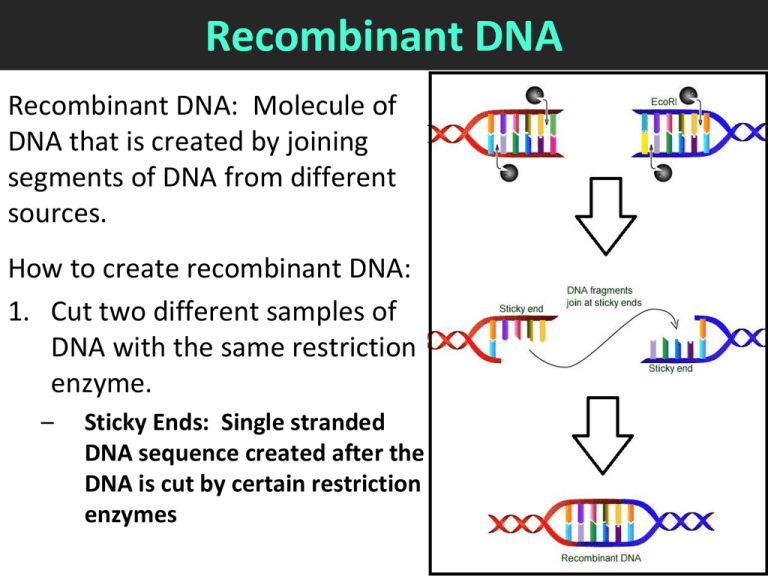Recombinant DNA
advertisement

Recombinant DNA Recombinant DNA: Molecule of DNA that is created by joining segments of DNA from different sources. How to create recombinant DNA: 1. Cut two different samples of DNA with the same restriction enzyme. – Sticky Ends: Single stranded DNA sequence created after the DNA is cut by certain restriction enzymes Recombinant DNA 2. Join the two cut DNA segments together. – Since both DNA molecules were cut with the same restriction enzymes the sticky ends will contain complimentary bases. – DNA ligase can be used to fuse together the DNA fragments. – Beside recombinant DNA, in what other process is DNA ligase used? Recombinant DNA How is recombinant DNA useful? Recombinant DNA can be inserted into bacterial cells to create human growth hormone. How to make bacteria with recombinant DNA: 1. Remove a plasmid from a bacteria cell. – Plasmid: A small, circular DNA molecule in bacterial cells that is separate from the bacteria’s chromosome. Recombinant DNA 2. Cut the plasmid and the human DNA with the same restriction enzyme. 3. Use ligase to join the fragment of human DNA containing the insulin gene with the cut bacterial plasmid. 4. Insert the plasmid with recombinant DNA into a bacteria cell. Recombinant DNA 5. The bacteria cell divides and produces more transgenic bacterial cells that will produce human insulin that can be given to diabetic patients. Transgenic Organisms: Organisms that have had genes from other species inserted into their genome http://www.youtube.com/watch?v=juP6iHMIYkE Cloning Clone: genetically identical individuals produced from a single cell. • Cloned colonies of bacteria and plants are easy to grow How to clone a mammal: 1. Remove the nucleus from a diploid cell of the animal you wish to clone. The cloned lamb is identical to which sheep? Cloning https://www.youtube.com/watch?v=-Qry1gYYDCA 2. Remove the haploid nucleus of an unfertilized egg cell and replace it with the diploid nucleus. 3. The diploid egg cell will begin to divide, growing into an embryo. 4. The embryo is implanted into a foster mother where it develops until birth. http://www.youtube.com/watch?v=hepoJgGJtNc&list=PLH82CVT4Euawhcq4CyRbnu6d55DcM_KfG The cloned lamb identical to which sheep? Ethics and Impacts of Genetic Engineering Understand the pros and cons of each of the following: 1. Genetically Modified Foods (GMO’s) 2. Designer Babies 3. Cloning Mammals





